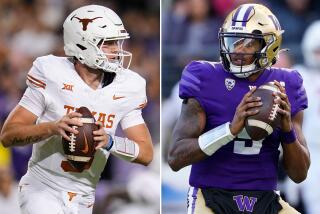FIESTA BOWL : Poor Playing Surface Concerns Coaches
- Share via
TEMPE, Ariz. — Expect a rousing game of sandlot football between Syracuse and Colorado in today’s IBM OS/2 Fiesta Bowl.
The field at Arizona State’s Sun Devil Stadium, where the game begins at 1:30 p.m., has deteriorated to the point where it’s virtually wall-to-wall sand. The field had been losing its grass since late November and twice the usual amount of rainfall in the area since has drowned what little remained. How bald is it?
“Pretty much from hash mark to hash mark, and probably from goal line to goal line, (the players) will be playing on sand,” said Tom Sadler, ASU stadium manager. “The sod and the Tifway (a hybrid Bermuda grass) have broken away, leaving a membrane of sand in the middle of the field. The area that the players will play on, for the most part, will be sand.”
A fine venue for a beach volleyball game, but, coaches here say, not appropriate for a New Year’s Day bowl game. The conditions drove Colorado Coach Bill McCartney to ask game and NCAA officials--in vain, it turned out, since his request was denied--to allow the players to wear three-quarter-inch cleats instead of the usual half-inch--the maximum allowed for college games.
The long, so-called “mud cleats” are considered safer on slippery surfaces. McCartney said the Phoenix Cardinals told Colorado’s equipment manager, “We’d better use the three-quarter-inch or else.”
“I think the field’s a factor,” McCartney said. “Do you go for it on fourth down if footing is a factor? Your field-goal range is affected. What the officials need to take into account is the safety of the players. We have a New Year’s Day bowl with very poor field conditions.”
In an NFL game played on the field last Sunday between the Cardinals and the Tampa Bay Buccaneers, there were six missed field goals. Afterward, players, especially the kickers, sharply criticized the footing. Even Sadler, the besieged stadium manager, said, “It looked like a sandbox.”
Syracuse Coach Paul Pasqualoni said Thursday that he was concerned about the field’s effect on the Orangemen’s kicking game, one of the best in the nation.
“We want to get our players on the field so that they can make whatever adjustments they have to make,” he said.
The adjustment will be more pronounced, considering that both teams’ home stadiums have artificial turf. The Fiesta Bowl will be Colorado’s first game on what is supposed to be natural grass this season.
Experts have been unable to pinpoint the cause of the problem, other than to complain about overuse and excessive rain. In fact, Arizona State has hired turf expert George Toma, who will arrive here after he prepares the Rose Bowl field for the Super Bowl.
Brent Brown, ASU vice president, said the stadium turf was in the worst condition than he has ever seen. That’s especially embarrassing, considering the $1.6 million the school spent after last season to improve the field, lowering the stadium floor three feet and installing a sophisticated heating system to simulate the balmy conditions the Tifway 419 hybrid Bermuda grass thrives upon.
Syracuse (9-2), ranked sixth, figures to be hurt most by the unsure footing. Its option offense requires speed and mobility, led by quarterback Marvin Graves and receiver Qadry Ismail.
Graves, though, can be a potent weapon. The junior has been the MVP of both postseason bowls he has played and has completed more passes, 392, for more yards, 5,919, than any quarterback in Syracuse history. He played well in a 16-10 loss to Miami in the last game of the season. But he was ineffective in Syracuse’s other loss--on national television against Ohio State.
Colorado (9-1-1), ranked 10th, has a strong defense anchored by All-American cornerback Deon Figures, who attended Serra High. A senior, Figures sat out his sophomore season for disciplinary reasons but has redeemed himself on and off the field and was given the Jim Thorpe Award as the nation’s premier defensive back.
More to Read
Go beyond the scoreboard
Get the latest on L.A.'s teams in the daily Sports Report newsletter.
You may occasionally receive promotional content from the Los Angeles Times.











